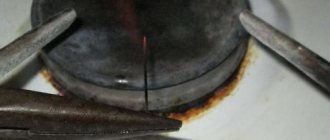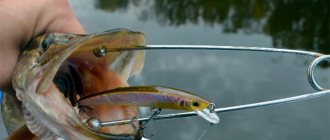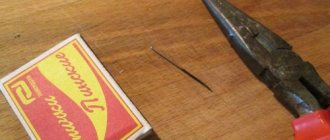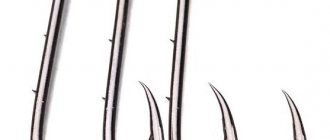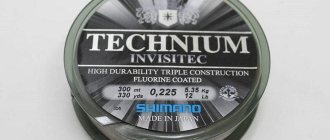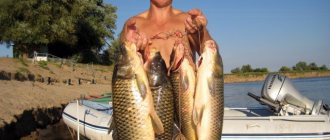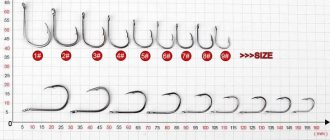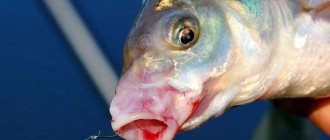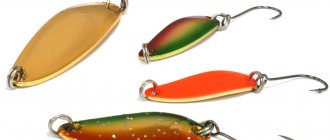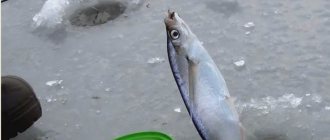Offset hook, in common parlance – offset hook, from the English offset hook, which translated means “hook with a shift”.
On it, the upper part is moved slightly to the side, thereby forming a Z-shaped bend in the upper part, the so-called step, which allows you to attach soft baits to it.
It is mainly used to mount silicone baits on it. Also, thanks to its shape, the hook allows you to make non-snagging baits.
It operates as follows : at rest, the sting is hidden in the body of the bait. When the fisherman makes a hook, it is released, and now the fish is already on the hook.
Varieties of form
There are several types of hooks. The difference is mainly in the shape of the bend of the forend, as well as the shape of the Z-step. A specific type of bait is selected for each shape.
Texas Hook
- Considered a classic offset printer.
- Used for soft or narrow baits (for example, vibrating tail worms).
- Often used for Texas rigging.
Wide Gap
- It has a wide bend, forming a gap, which, in turn, acts as a lever. This makes it easier to hook fish.
- Used for hard and hard baits.
- There are two types of such hooks. One is suitable for narrow-bodied lures, the other for tall ones.
Sickle Hook
- It has a crescent shape.
- It is a relatively new model.
- Suitable for complex rigs and long casts.
- Self-hooks the fish when it bites and prevents it from falling off.
- Holds fish when landing.
Models with lead loading on the forend
- Most often they have a Wide Gap shape.
- Designed for casting over short distances and spot fishing.
- Does not require additional loads.
Types of offset hooks
Second life of silicone baits
Probably, all spinning anglers who have ever fished with silicone baits are familiar with the situation when a completely new vibrotail or twister turns the first bee-eater that pecks into something like a washcloth, or even leaves it without a tail. But don’t rush to throw away the damaged bait; you can still catch quite a few predators with it!
And in order to give the bait a second life, you don’t need to be a wizard, it’s enough to have two hands and a source of fire; best of all, a lighter and a candle are suitable for these purposes.
“Healing” deep cuts that remain on silicone after contact with sharp pike teeth is the easiest “procedure”. It is enough to bend the bait with one hand in the opposite direction from the cut (so that the cut appears to open) and heat the damaged area to such an extent that the silicone begins to melt.
Then we connect the cut places together and after a few seconds, after cooling, we have a flat surface. You just need to try to prevent the silicone from igniting and, in this case, I recommend using a lighter rather than matches. A gas flame produces less soot than a wood flame, and the soot, when mixed with molten silicone, changes its color.
I hope the cuts have been sorted out. Now, why do we need “tailless” baits? Sometimes among the “rubber” there are real centenarians who have exterminated more than a dozen predators in their lifetime and are reminiscent of Bruce Willis at the end of the movie “Die Hard.” The body of such centenarians is damaged, both externally and internally, to such an extent that it practically no longer holds on to the jig head, sliding onto the hook even with slight contact with algae or anything else. Manipulating such a bait with a lighter will not help much. You can, of course, try to glue the bait to the jig head with glue, but it is better to perform an “organ transplant”. Our pike fighter will act as a donor, and the bait deprived of a tail will be a patient who requires a transplant of this very tail.
So, we cut off its most valuable part, that is, the tail, from the battered silicone fish (donor). And from the remaining fish without a tail (as a rule, there is no shortage of such material), we choose the most intact one. Next we will need a candle, since both hands will be busy. We light a candle and, holding the tail and body of the silicone bait in different hands, heat the places of the future connection on its flame. After the silicone begins to melt, press the tail tightly to the body. In less than half a minute you will have a practically new silicone fish.
Using the same method, you can create your own original “rubber” colors by welding parts of baits of different colors. It should be noted that a bait properly welded in this way is no different in strength from a new one.
But since there will always be a clear shortage of tails, and an overabundance of bodies, you can create a completely new bait. This will require thin rubber; rubber gloves, scissors and glue (waterproof, “moment” type) and at least one whole twister are perfect for our purposes. And then everything is very simple - we apply the tail of the twister to a rubber glove, trace its outline and cut it out. On the body of the bait, where the tail used to be, we make a longitudinal cut about five millimeters deep and glue the tail from the glove into it. Depending on whose body was borrowed, either a new twister or a hybrid of a twister and a vibrotail is obtained.
And believe me, tails made from rubber gloves work no worse than the original silicone ones, and predators like them just as much. This is how “life after death” turns out.
Article taken from the site: https://club-fish.ru/spinning/vtoraya-zhizn-silikonovyh-primanok.html
And another video on the topic:
Rules for placing bait
The success of the retrieve will depend on how well you make the bait from the bait. This will also affect whether the hook will cling to underwater vegetation and snags. To make a great attachment, you just need to follow the instructions.
The twister attachment is made as follows:
- The twister at the end is pierced by 5-7 mm.
- A 90 degree bend is made.
- This is done in order to repeat the Z-shaped bend.
- The hook is pulled out to the end (to the Z-shaped step).
- Next, we make a perpendicular puncture in the body.
It is necessary to make a perpendicular puncture so that the tip does not stick out, but fits neatly to the twister.
It is also important not to pierce the body after everything is done. This is a fairly common mistake.
But in this case, it is unlikely that the sting will be able to pierce both rubber and fish.
Installing a vibrating tail is very similar to installing a twister, but nevertheless is somewhat different:
- From the front (from the side of the head) we pierce the bait downwards.
- We carry the bait to the offset eye.
- We find the puncture site by trying on the hook.
- We puncture the vibrotail and bring the sting out.
The mistakes with a vibrotail are the same as with a twister, namely, after the equipment is ready, the hook is implanted into the rubber, or is not removed from it at all. If you can’t do everything right right away, don’t be upset. It's a matter of experience. In addition, most fishermen make bait in their own way.
Installation of offset hook to fishing line
There are several ways to connect a hook to a fishing line: “Palomar” and “Clinch”. At the moment they are the most popular and widespread. Both of these units hold the offset machine quite tightly, which helps to avoid troubles while fishing.
To make the Palomar knot, you need to perform the following manipulations:
- Fold the fishing line in half.
- Thread the fishing line into the eye of the rig.
- Tie a simple knot.
- Throw the folded end of the fishing line over the hook.
- Tighten the knot without using too much force.
- Trim off excess line.
The second variation is the Clinch knot:
- Insert the line through the hole in the eye.
- Wrap the hook around the fishing line 6-7 times
- A loop is formed near the ear. You need to thread the end of the fishing line through it.
- Tighten the knot carefully and without sudden movements.
- Trim off excess line.
Criterias of choice
When you want to buy such a product, you should know a few things that will help you choose a hook that won’t break as soon as you throw it.
The choice should be approached with full responsibility. It is worth considering all factors, from size to the material from which it is made.
The choice should be based on the size of the bait you are going to fish with and the size and weight of the fish you plan to catch.
Dimensions
There are 7 sizes:
- No. 1/0. Forend width - 1.25 mm. Length - 41 mm.
- No. 2/0. Forend width - 1.35 mm. Length - 44 mm.
- No. 3/0. Forend width - 1.45 mm. Length - 47 mm.
- No. 4/0. Forend width - 1.55 mm. Length - 50 mm.
- No. 5/0. The width of the forend is 1.65 mm. Length - 55 mm.
- No. 6/0. Forend width - 1.75 mm. Length - 60 mm.
- No. 7/0. Forend width - 1.85 mm. Length - 65 mm.
But it is worth noting that often the hook dimensions may not coincide with the manufacturer’s dimensions. The size is selected according to the bait used.
Materials
The materials used in the manufacture of offset presses also differ. Carbon stainless steel is mainly used, but they can also be bronzed, nickel-plated, or coated with titanium nitride. To prevent corrosion, special coatings are used.
Manufacturers
The quality of the product also depends on its manufacturer. There are many manufacturers on the market offering to buy their product. There are sellers of better quality, and there are sellers of worse quality.
Here are the manufacturers that have proven themselves best:
- Owner (Japan).
- Gamakatsu (Japan).
- Decoy (Japan).
- Mustad (Norway).
- Crazy Fish (Ukraine).
- Kosadaka (Japan).
- Maruto (Japan).
- Cannelle (France).
- Cottus (China).
- Kushiio (South Korea).
When choosing, you should pay attention to the angle at which the Z-shaped bend of the forend is located. It is better to choose those models in which the bend is sharp, this way you will protect yourself from the bait falling off.
In any case, you shouldn’t save much and buy the cheapest product. It is unknown how he will behave in an extreme situation.
Perhaps because of your savings, you will not pull out the fish you have been waiting for so long. The main rule is that a stingy person pays twice.
How to choose an offset hook
Of course, the first thing you need to do when buying an offset hook is to purchase a bait of the correct shape and structure for it. If you buy a hook and bait separately, then the likelihood that they will not suit each other is high. A very important factor is the thickness and strength of the wire used in the manufacture of the offset press. For example, if you are going to catch a predatory fish such as asp or pike, then you should choose hooks made of thicker metal so that the hook does not bend under the pressure of the fish.
Making an offset hook at home
- You should buy regular single hooks, but preferably with a long shank.
- Due to some of the manipulations that the hooks undergo, they may break, so you need to heat them slightly using a small fire (a lighter is perfect).
- After the hook has cooled, you can begin to give the desired Z-shape by slightly bending it.
As you can see, there is nothing complicated, and if you have the desire, you can easily build an offset hook yourself. At the same time, you have the opportunity to make it exactly the type that you need. But it should be taken into account that an offset press made in this way differs significantly in strength from a factory one, since the latter goes through the stage of metal hardening, under certain conditions.
DIY making: step-by-step process
There are cases in which it is not possible to buy an offset hook. For example, when we went fishing we took only ordinary hooks when we had to take offset hooks.
What to do in such situations? Everything is much simpler than it might seem, because it can be made from an ordinary one with a long forend. But it is also important that the steel is of high quality.
It’s very easy to make, and given the high prices for offset presses, you can make several hooks at once, thereby saving a lot of money.
- All hooks are made of hardened steel, which we have to bend. But if you immediately start bending it, it will easily crack. To prevent this from happening, you need to hold the part that is to be bent over a small fire, namely the tip on which the step should be located.
- When the metal has cooled completely, it can be carefully bent. It is very important to do everything smoothly and without sudden movements.
- The first bend is made downwards, the next one up.
- The result is a finished offset hook, completely ready for use.
Catching pike in the toad grass in the fall / do-it-yourself loaded offset box
When fishing for pike in overgrown reservoirs, the so-called “toad beds,” spinning anglers most often use various installations of silicone baits on offset hooks, with or without additional loading. Silicone baits equipped according to this principle allow you to successfully fish in conditions of “increased overgrowth”, where it is difficult to work with other baits, and most often simply impossible.
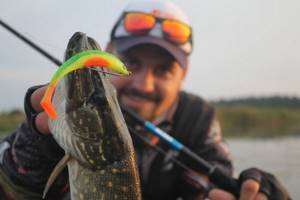
With the first rays of the sun, the pike in the fronds also wakes up.
But it is not always possible to select ready-made offsets with the required load weight, which is already on the shank of the hook, for certain fishing conditions. And here specialized weights designed for offset hooks come to our aid. They have a wide range of weights, a streamlined shape, a special groove for fastening - a completely thought-out theme, ready for use.
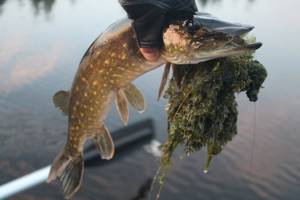
A common picture when fishing a pike out of the grass.
With this installation, the offset maker in the silicone bait can be attached in the usual way and using a “corkscrew”, which is screwed into the head of the bait. In the first case, the step of the offset hook is hidden in silicone and does not collect filamentous algae, but this design turns out to be non-removable, and if the silicone is damaged, you need to remove the weight in order to re-equip the bait.
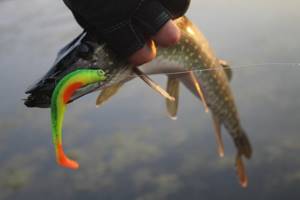
Often, silicone does not require additional weight when fishing in overgrown shallow waters.
In the second case, in tandem with the “corkscrew”, we get a quick-release mount, but the offset step sticking out in the head of the bait can collect various debris. But silicone on such equipment can withstand more pike attacks. Both designs are highly passable through thickets of algae, snags and similar difficult places. And depending on the fishing conditions, one or another equipment is used.
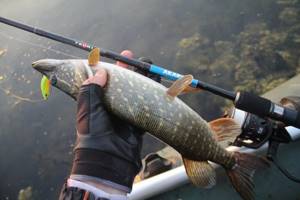
Mostly, the pike you find in the toad fields is not large, but that doesn’t make you less emotional!
The load itself is secured by pressing it onto the fore-end with any tool that is at hand (but not with your teeth!). The weight can be placed anywhere on the offset fore-end, depending on how we want the bait to sink. If you place the weight at the head of the bait, it will sink head down, if at the tail, it will sink with its tail back, and if in the middle, it will sink in a horizontal position, maintaining an attractive game.
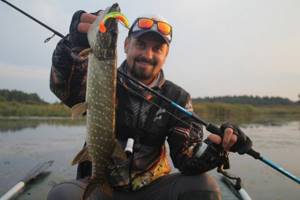
It is better to use more powerful gear in order to be able to forcefully fish it out of the thickets.
Fishing on such types of reservoirs is always interesting and spectacular! By selecting suitable baits and equipment for each new and promising section of the reservoir, we will definitely get results; experiments in fishing are always welcome!
Catching pike in the toadstool in the fall with a spinning rod is a very spectacular activity. Unweighted silicone baits are quite difficult to cast far, then it is very convenient to make a weighted offset hook with your own hands using a Minza weight from the Ivva company. The video shows fishing in September 2021 on one of the overgrown reservoirs of Belarus. In the last video, Ivan Mazovka already spoke in detail about the TOP lures for catching pike in the grass: youtu.be/aMFFOmHvdYo Our online store in Belarus: lovisnami.by/ We are on VKontakte Fishing in Belarus: vk.com/fishing47 We are on Instagram: instagram. com/lovisnami__by/ #pike #fishing #spinning
